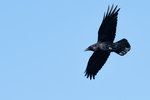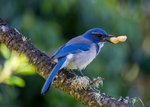

Jays and crows, members of the Corvid Family, are among our most common birds. Most are not all that colorful, and males and females look alike. But they all have interesting stories to tell.
Everyone knows what an American Crow looks like: semi-large as songbirds go (about 16"), and all black. Their "caw" vocalization can be heard almost anywhere.
Have you seen large numbers of crows flying the same direction in the evening? Turns out we have two large crow night roost sites in north county. From the east side of Olympia, the crows are flying east toward a roost near St. Peters Hospital. From the west side, they fly west toward a roost located on Eld Inlet near The Evergreen State College.
They'll remember you
Crows are smart and can recognize individual people. A friend of mine told me an interesting story about crows. Years ago, she found an injured crow in her backyard and there were many other crows in the nearby trees loudly vocalizing and watching over their comrade. They became very agitated when she approached the injured crow. She decided to take water and food out to her "patient," and at her first approach she was aggressively dive-bombed. To quote a certain Senator, "nonetheless, she persisted." This feeding went on for four days, but the watchers never again harassed her. They seemed to know what was happening. The injured crow recovered, and finally it and the protectors flew away.
Jays
Steller's Jays are the most common jay in our area. They are also fairly large (about 12"). Their dominant color is dark blue, with its upperparts blackish. They are our only bird with a very visible crest on its head. These Jays hang out in and around tall conifers and mixed wooded areas. Their voice is very distinctive; it's a loud, harsh "sharrk, sharrk."
Steller's Jays have good mimic skills. Many will imitate a Red-tailed Hawk's alarm call when threatened. Once when I was doing a bird survey I had already written "RTHA" into my notebook when, from the back of a nearby conifer, a Steller's Jay flew out, continuing his hawk alarm call.
We have another jay in our county too: the Western Scrub-Jay. Not too many years ago this jay was quite rare. Christmas bird counts from 20 or so years ago didn't include Scrub-Jays. A 2000 map of the scrub-jay's range barely reached Washington State. Now, after 20 years of rapid expansion, the scrub-jay is fairly common. This rapid expansion has avian researchers puzzled. There doesn't seem to be any obvious reason for it.
The Scrub-Jay is lighter blue than the Steller's and covers only its back and head. It has no crest, and a whitish belly with a partial blue streak across it. These are active and seemingly friendly birds, not hesitant to hang out in human neighborhoods.
The Raven
Finally, no account of the Corvid family would be complete without mention of the Common Raven, at 24" our largest songbird. The raven is all black, like the crow, but usually will appear much larger, with a very large and bold bill. Sometimes it might be difficult to know which bird you are seeing, so here are a few hints: Flying, it's sometimes hard to tell size; however, the raven has an obvious wedge-shaped tail while the crow's tail is straight across. Also, ravens typically will be flying in pairs, not as singles or flocks, and this pair will vocalize back and forth with a loud "croak" or "raawk." It's a very distinctive sound, unlike anything a crow will utter.
I often notice pairs of ravens patrolling roads and highways in the morning. It would seem that they are looking for new road kills since carrion is one of their important food sources.
George Walter is the environmental program manager at the Nisqually Indian Tribe's natural resources department; he also has a 40+ year interest in bird watching. He may be reached at george@theJOLTnews.com
Most photos for this column are provided by Liam Hutcheson, a 14-year-old Olympia area birder and avid photographer.
1 comment on this item Please log in to comment by clicking here
Drutty
Thank you. Am loving these articles to appreciate our birds~!
Friday, June 24, 2022 Report this